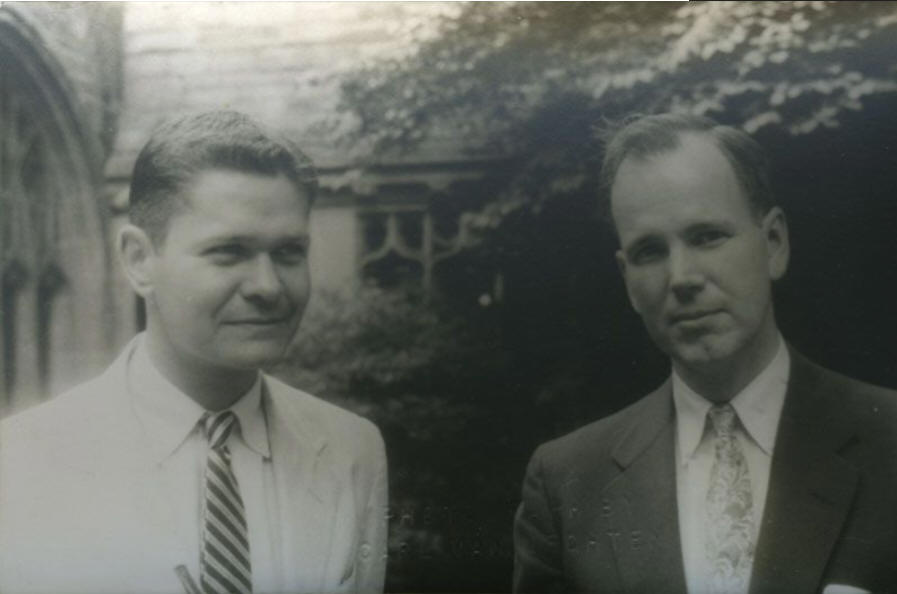

Queer Places:
295 Crown St, New Haven, CT 06511
Yale University (Ivy League), 38 Hillhouse Ave, New Haven, CT 06520
University of Oxford, Oxford, Oxfordshire OX1 3PA
Evergreen Cemetery
Moosup, Windham County, Connecticut, USA
 Donald Clifford Gallup
(May 12, 1913 - September 6, 2000) was a bibliographer, editor and curator.
His career was entirely spent at Yale University, and closely parallels the rise of American literary archives to their present unchallenged supremacy. With sharp-eyed rivals at Harvard, Princeton and the University of Texas at Austin, Gallup was that bit sharper, and better connected. His skills as a courtier were no less fabled than his gifts as a bibliographer.
Donald Clifford Gallup
(May 12, 1913 - September 6, 2000) was a bibliographer, editor and curator.
His career was entirely spent at Yale University, and closely parallels the rise of American literary archives to their present unchallenged supremacy. With sharp-eyed rivals at Harvard, Princeton and the University of Texas at Austin, Gallup was that bit sharper, and better connected. His skills as a courtier were no less fabled than his gifts as a bibliographer.
He was for three decades curator of the Yale collection of American literature, during which period he published the standard bibliographies of T.S. Eliot and Ezra Pound, and edited numerous manuscripts by Gertrude Stein, Thornton Wilder, Pound and Eugene O'Neill held in the Yale library. He curated exhibitions at Yale, addressed learned societies on bibliography, and seemed to have his thumb on virtually every modern literary discovery.
The son of a lumber worker in Sterling, Connecticut, Gallup attended Yale during the height of the depression. The Johnsonian scholar Chauncey B Tinker singled out his promise, and, after graduating in 1934, he wrote his doctoral dissertation on Giuseppi Baretti, a friend of Johnson's biographer, James Boswell.
The discovery of the Boswell papers at Malahide castle in Scotland, and their purchase by Yale in 1949, strengthened the identification of the university with 18th-century scholarship. After Gertrude Stein's death in 1946, Yale purchased her papers, and Gallup joined the team which published her unpublished writings. It was Stein, not Boswell, who represented the future direction of the Yale literary archive.
Gallup was crucial to the emerging reputation of Yale as a force in modern writing, having published a catalogue of Eliot's first editions, which were exhibited at Yale in 1937. That early catalogue formed the basis for a more detailed Eliot checklist in 1947, and for Gallup's full-scale bibliography of Eliot, published in 1952. It was not a commercial success, selling only 150 copies a year before being pulped in 1963. An expanded edition appeared in 1969.
When the manuscript of The Waste Land was discovered in the New York Public Library, Gallup was asked by the Times Literary Supplement to write an evaluation of the manuscript. In effect, he introduced the literary discovery of the century to a wider public.
Gallop's earliest literary passion was as a collector; while still a graduate student, he spent his spare money purchasing Eliot's early, and, on London trips, began collecting the sketches and paintings of Edward Lear. Back in wartime Britain with the US army, he continued to acquire first editions and rare titles by British writers, and, in 1945, spent a term at Magdalen College, Oxford, studying bibliography with David Nichol Smith.
In 1997, Gallup donated his $1m collection of Lear materials, which included seven oils and more than 300 drawings, to Yale's British art centre. Later, he donated a 13-shelf foot collection of the works of Lawrence Durrell.
Gallup's enthusiasm for Eliot was soon followed by an interest in Ezra Pound. Both writers had notoriously complicated private lives, and it took all of Gallup's charm and persistence to keep Pound's parents, wife, mistress, son and publishers sweet. He visited the Pound materials looked after by the poet's former mistress, Olga Rudge, at Sant'Ambrogio di Ripallo in 1957, and returned to Italy in 1961 on a Guggenheim fellowship, by which time the Pound papers were under the control of the poet's daughter, Princess Mary de Rachewiltz. Gallup's monumental Pound bibliography of 1963 was built upon materials he had purchased over the preceding two decades.
Yale University Library published two volumes of Gallup's reminiscences, Pigeons On The Granite (1988) and What Mad Pursuits (1998). In the spring of 2000, Jonathan Edward College, at Yale, staged an exhibition of paintings and drawing by Elie Lascaux from the Gallup collection. As a bibliographer, he was responsive to the needs of scholars, rare-book dealers and collectors. The purpose of a bibliography, he argued in a lecture in 1970, was "to establish the facts, clear away confusion, and create order."
My published books: